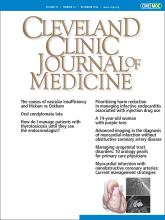
Two articles in this issue of the Journal address the pathobiology of vascular insufficiency. Although the target organs are different in the 2 patients presented, skin and heart, the diagnostic implications have similarities.
Buda et al1 discuss the evaluation of a 53-year-old patient with myocardial injury and acute myocardial infarction diagnosed by the clinical history and time course of troponin level changes. Elkin and McGervey2 discuss a 74-year-old patient with discoloration of her feet, foot ulcers, and purple toes. Buda et al’s patient had a long-standing history of human immunodeficiency virus infection managed with ongoing antiretroviral therapy, and, despite the myocardial infarction, no obstructive epicardial coronary obstruction was demonstrated on initial coronary angiography. Elkin and McGervey’s patient with symptomatic ischemic changes on examination of her feet had a history of Raynaud phenomenon, polycythemia vera, previously treated breast and thyroid carcinomas, deep vein thrombosis, and hypertension.
The success of acute and chronic management strategies for both of these patients depends, in part, on the correct recognition and reversal of the dominant factor(s) contributing to their myocardial and soft-tissue ischemia. In academic exercises such as the clinicopathologic conference, the discussant reasons her or his way through the details of the patient’s disease course and proposes a unifying diagnosis. The “diagnostic test” is then presented, which will support or refute the proffered diagnosis.
On teaching rounds and in the clinic one-on-one with a new patient, we pursue a similar mental exercise, hoping to arrive upon a dominant diagnosis. We do this while, as seasoned clinicians, fully realizing that for most of our older adult patients there is rarely just 1 pathologic actor on stage. If indeed there were no obstructing coronary lesions present, did the retroviral infection contribute to low-grade coronary inflammation, metabolic dysregulation, or microvascular obstruction in this 53-year-old man? In the woman with ulcers and purple toes, did prior carcinomas and therapy contribute to endothelial damage, is the history of venous thromboembolism relevant to her current apparent arterial disease, what is the contributory role of the polycythemia vera, and what of the history of Raynaud phenomenon? In other words, is our ingrained reflexive search for a single explanatory diagnosis always reasonable and warranted—or is it truly “just” an academic intellectual exercise?
When reflecting on the landscape of my patients, I don’t believe it is a futile exercise. The effort forces us to consider the possibility of a single pathway to expression of the dominant clinical problem(s) at hand. But I also recognize that, for many patients, there is not a single diagnostic explanation for their entire clinical scenario. This got me thinking about Occam’s razor,3 which states that the single unifying diagnosis is the best, and Hickam’s dictum,4 stating that there may be several contributing diagnoses. And down the Internet greased rabbit hole I went.
Occam’s razor, although embraced by William Osler and expressed by many medical educators since as “diagnostic parsimony,” is not originally a medical construct. The original concept likely was born from Aristotle, who felt that the simplest explanation for a complex problem was likely the best. William of Occam (or Ockham; 1285–1348), a philosopher who was charged, presumably for other reasons, with heresy by the papal court,5 popularized Aristotle’s concept of simplicity and avoidance of excessive assumptions: “Plurality must not be posited without necessity.”6 It has ultimately made it into our medical aphorisms as, “When explaining a complex set of symptoms, a single diagnosis is better than invoking 2 or more unrelated ones.” The reality of course, in other than 9-year-olds, is that the biologic canvas is rarely blank, and there are often confounding, if not impactful, clinical contributors to the expression of what has been termed the “end-point diagnosis.”7
Hence, the counter to Occam’s razor is expressed as Hickam’s dictum. This has been attributed to Dr. John Bamber Hickam (1914–1970), who was a well-recognized cardiopulmonary physiologist, chair of the Department of Medicine at Indiana University, and medical educator.8 I have not been able to find in print his folksy aphorism, but many authors have attributed this to him*: “A patient can have as many diseases as he damn well pleases.” As an admonition to avoid premature diagnostic closure, this is a linchpin concept in the application of evidence-based medicine to the patient in front of us. Its applicability has recently been evaluated in a review of published case reports.4 Its invocation should not stand in the way of attempting to piece together multiple components of a given patient’s clinical picture with a single explanation—if that can be done with minimal assumptions and limited stretching of statistical likelihood. Plus, it is satisfying when we can do it.
Footnotes
↵* If anyone has an actual citation attributing that phrase to Dr. Hickam, please let me know.
- Copyright © 2024 The Cleveland Clinic Foundation. All Rights Reserved.






